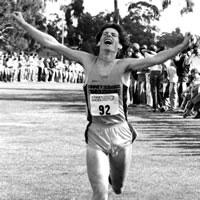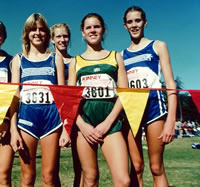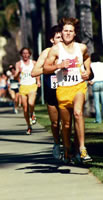|
Kinney/Foot Locker
Cross-Country Series over 25 years
   
Foot Locker photos of early
"historymakers" in the Kinney/Foot Locker series (l-to-r):
Matt Guisto's dramatic 1983 FLCCC win; Ceci Hopp (green/yellow) wins;
Jay Marden
(the California-based champion); Janet Smith (New Jersey's own record-setter).
From what started as an idea tossed
around among the family members of an executive within the Kinney business
organization, the Kinney, most currently Foot Locker National Prep Cross
Country Championships, have been the most significant thing to happen
to the harrier sport since its inception. The bringing together of athletes
from the different regions of the nation to a national championship competition,
with the timing following the regular prep season, has made it the only
activity at its level with a true national championship attended by all
the top athletes in the sport. If someone is not at the National prep
cross-country championships started by Kinney and carried forth by Foot
Locker, one always knows why, and it is a darn good excuse if they are
not, the series is so meaningful and important to all involved. The meaningful
expenditure of effort in preparation over a period of weeks or months
for the thousands of athletes each year who trek to the Regional competitions
and hope to make it to the National Finals is immeasurable. No one who
runs quality high school cross-country is unaware of the National Championship
series in the sport. The lifting of the sport in different areas of the
nation can be attributed to the contact that runners from those areas
have had with those from all areas of the nation at the national championship
competition, when runners headed back home and realized that those folks
who may for a time run a tad faster seemed to put their shorts and shoes
on the same way that everyone did. The inspiration of the National Championship
weekend, with no shortage of alums who have gone on to the Olympic level
in fine style, is marked by many who return in that capacity as the most
signficant occurrence in the early part of their running career.
We have been fortunate enough to be involved
along the way, and have a treasure trove of conversations, observations
of races, and general experiences at that championship level that form
a rich history to the mid-December portion of each year as it ends the
fall cross-country season. One never ceases to be amazed by stories like
that of Bridget Klein, a qualifier from Alaska, who matter of factly stated
that her coach used to come along with her on training runs as she readied
for the nationals, because, “When you are running in steady 50 mile
and hour winds it is best to have someone take you out and run back with
the wind,” or “it is nice to have a car to jump into when
a bear comes along during the run.” Gee whiz, and you are complaining
about a sore shin or sniffles!! In addition to the great competitions
and successes along the way it is conversations such as these who help
make up the deep history of the Kinney, and most recently Foot Locker,
National High School Cross-Country Championships.
25 years of History
Did you know that the first Kinney National
Cross-Country female Champion, Ellen Lyons of Boise, Idaho, could run
downhill faster than the go-kart with the camera attached filming her
to the rear, with the highlights race from the first 1979 competititon,
featuring Lyons waving to the vehicle during the race to please move the
heck out of the way while she rocketed downhill in Balboa Park in San
Diego on the way to her win. Of course, the TV folks before the contest
asked Meet Director Fred LaPlante of San Diego State University if the
runners could not please stay close together for the first two miles and
race the last mile so it would look good for TV. LaPlante diplomatically
explained that that would not work for the show. LaPlante as a University
Coach, had to step aside early in the series, with his position an obvious
conflict of interest that the NCAA would eventually have had some serious
problems with. Of course, some early contestants in the Kinney National
series stayed in housing provided by NCAA Coaches, another situation rectified
early in the Championship series when possible collegiate rules violations
were pointed out. This was way back when the sense of a prep national
championship was so new that many situations had never been conceived,
and with the best of intentions the Meet Direction group quickly had arrived
at a formula that allowed the top runners from across the nation to go
at it on a Championship level course with all the details off to the side
falling into immaculate place such that they could concentrate on the
excellence of their running.
What were some of the highlights of these races
during the last 25 years - let’s try to give a bit of a sense of
history to the competitions since 1979, with a story or two along the
way.
1979
This initial competition, held in Balboa
Park in San Diego on a course different than the one currently used, immediately
showed the great diversity geographically to the quality in the sport.
The Boys’ winner the first year turned out to be Brent Steiner (Shawnee
Mission South, Overland Park, Ks), who had run 8:47.0 for the previous
year for a full two miles on the track. Barasa Thomas (Santa Barbara,
Ca), a Kenyan foreign exchange student, who had won the Western Regional,
stayed close to Steiner’s blistering 4:30 first mile in the National
race, with a 100 yard concrete switchback at two miles allowing the Kansan
to gain most of the margin he kept into a 15:05-15:10 win. Dwight Stephens
(Williams, Alexandria, Va) was third at 15:18, with Andi DiConti (La Canada,
Ca) fourth at 15:27, and Jim Smith (Haddonfield, NJ) 5th at 15:27.
The Girls’ contest that first year had Ellen Lyons (Bishop Kelly,
Boise, Id) complete two years of undefeated action in the sport, romping
to a 17:28 Course Record run (set by San Diego State’s Lynn Kanuka
the same year at 17:48). Idaho, not exactly thought of as a hotbed of
American prep distance running, showed the amazing nature of these championships,
where athletes who do not necessarily face national level competition
each weekend or two can rise to the occasion at the national level competition.
Lyons had led early in the race through a 5:12 first mile, with Roxanne
Bier (Independence, San Jose, Ca) moving into the lead before the tough
switchbacks at the two mile point, with Lyons closing very strong over
the last mile to win by over 100 yards. Lynn Strauss (College Park, Pa)
ended second at that first year meet, with Ann Galdue (Bayley-Ellard,
Madison, NJ) third at 17:51. Californian Bier was fourth at 17:56, with
Suzanne Girard (Maine-Endwell, Endwell, NY) fifth at 17:56.
1980
There were five regions in those days,
with seven from each of the different areas making it to Nationals (thirty
five in total for each of the Boys and Girls contests. The athletes this
year were housed at the famed, historical Hotel Del Coronado, on the shores
of the Pacific Ocean, with the San Diego weather cooperating (as it usually
does), with daytime December weather in the 70's, with banquets and weekend
treatment befitting royalty. With many of the athletes coming from areas
of the country where December brought anything but hospitable running
conditions in the weather department, the San Diego weekends typically
are something out of a fairy tale for most of the participants. To be
honest, any year with weather conditions of above 70 degrees for race
time, there were heat problems for some of the athletes from other parts
of the nation, with anything below 75 degrees for Southern Californians
considered on the “chilly” side. With the current racing schedule
having the Championships done by 10:30 am on Saturday morning, heat is
not a condition of consideration, with the second race on the schedule
for many years with the schedule used finishing after 11:00 am in the
morning, a time when local heat can become an issue when you are used
to running in freezing conditions in the weeks leading up to the title
run.
Anyway, 1980. Again, some great races with
interesting results.
The Girls race had Ceci Hopp (Greenwich, Ct) rocket to the front and race
away from the pack to another large individual win, by 50 meters over
last year’s runner-up, Lynn Strauss (State College, Pa) 17:12-17:20.
They both took down the CR by Ellen Lyons from last year, so they had
done some super running! Vicki Cook (Alemany, Mission Hills, Ca) 17:31
was third, with Sandy Forsythe (Memphis, Tn) 17:36 in fourth and Millicent
Anderson (Canyon del Oro, Tucson, Az) 5th at 17:48. Ceci Hopp and Ellen
Lyon started the tradition of top athletes from this competition heading
on to Stanford, with the duo forming the leadership of Coach Brooks Johnson’s
super squads of the early 1980's.
The Boys from the West region seemed to handle this warm morning the best
in their contest, with that area of the country going five of the top
seven. Jay Marden (Mission San Jose, Fremont, Ca) took the race in a Course
Record 14:53 (taking down the 15:05 from last year by Brent Steiner) over
southern Cal rival Jon Butler (Edison, Huntington Beach) 14:57. Marden
had traded the early pace-setting with Marty Beauchamp of New York, with
Butler going from fourth to second in the final half-mile and ending up
25 meters short at the finish. Beauchamp (Tupper Lake, NY) was the first
non-Western region athletes at 15:00 in third, with Tim Hacker (North,
Menomonee Falls, Wi) 15:03 in fourth, and Tom Ansberry (Santa Rita, Tucson,
Az) 15:04 in fifth. Hacker went on to win the NCAA Cross-Country title
at University of Wisconsin, and was able to get down to 3:34.66 for 1500
meters. Ansberry starred at the University of Arizona.
1981
The 1981 competition was moved to
Orlando, Florida, with course a completely flat one, with the course deceptively
slow with patches of grass and sand during the 5000 meter contest.
Midwestern and Northeastern Girls ran well in this competition, with Connie
Roberson (Reading, Cincinnati, Oh) and Lois Brommer (Mechanicsburg, Pa)
separating early from the pack and running head and head the entire way,
before Roberson edged ahead on the finishing kick, 16:40.4-16:43.2. Lynn
Strauss (State College, Pa) continued her high finishes in third at 16:59.9,
with Laura Craven (Beechcroft, Columbus, Oh) 4th at 17:01.0, and Janet
Smith (Stevens, Edison, NJ) 5th at 17:11.7.
The Boys’ contest featured
a large pack that only separated in the final half mile, with Charles
Alexander (St. Christophers, Richmond, Va) a very strong finish to win
14:51.9-14:55.9 over Harold Kuphaldt (Bella Vista, Fair Oaks, Ca). Westerners
went 3-4, with Eric Reynolds (Camarillo, Ca) 14:58.3 and Keith Morrison
(Peoria, Az) 15:00.8. Mike Connelly (Upper Perkiomen, Pennsburg, Pa) was
5th at 15:01.2. This was the first year when it was pointed out that the
single week between the Western Regional, which must be held the week
prior to the Nationals, may have put together a very tough racing schedule
for people from California. The folks from that populous state, who currently
run their state meet the Thanksgiving weekend after tough sectional competition,
then move on to rugged regional, and the next week National level competition,
have no week’s gaps in the tough racing schedule, like those in
other areas, who have a week off between the Thanksgiving time Regionals
and Nationals. Race winner Charles Alexander became another Kinney Nationals
winner who packed it off to Stanford for a good career, and still shows
up in area road racing results in Northern California, where he has remained
after graduation.
1982
It was back to Florida once again for the
1982 competition.
In the widest Boys’ win thus far
in the series, and running a race described by National Meet Director
Max Mayo, as, “One of the most dominating in National Finals History,”
Eric Reynolds (Camarillo, Ca) ran away from the pack during a 14:35.7
5000m win on a flat course that Mayo described as deceptively tough in
the way of step to step footing. Back in second, nearly 100 meters behind,
was Mike Connelly (Upper Perkiomen, Pennsburg, Pa) at 14:49.5. Stephen
Taylor (St. Mary’s, WV) was third at 14:53.6, with Michael Collins
(Rye, NY) 4th at 14:54.1 and Anthony Smith (Port Chester, NY) 5th at 14:54.6.
Reynolds ran a solo 8:44.0 two mile that next spring in track, the #4
time in prep US History, with the tall, long striding Southern Californian
felt to be one of the area’s all-time greats. The Northeast won
the Boys’ team scoring that year with a small 29 point total. Reynolds
went to UCLA after high school, and a series of injuries held him back
from ever achieving what many felt to be a national or olympic class potential
there. Article
on Reynolds post-Kinney running
The Girls competition in 1982 had junior Christine Curtin (Mepham, Bellmore,
NY) the winner at 16:58.6, with Michelle Rowan (Washington Township, Sewell,
NJ) next at 17:02.3. Californian Cory Schubert (Del Mar, San Jose) was
third at 17:04.6, with Andrea Volpe (Lake Braddock, Burke, Va) 4th at
17:06.2, and Janet Smith (Stevens, Edison, NJ) 5th finisher at 17:13.6.
Curtin, a 12-time New York State Track and Cross Country champ, established
a Course Record on the regularly run Van Cortlandt Park Course in New
York City in 1981, and was a fine 4:43.5 miler the next 1983 spring track
and field season.
1983
In 1983 the meet moved back to San Diego,
with the course run over 5000m on the Morley Field portion of Balboa Park
that would be used for nearly the next two decades. The Figure 8 course
featured two good hills and enough ups and downs to give the contest a
sense of true cross-country. Most of the race featured grass as the footing,
with short sections going across the cement roads along the way. The hill
would come just after the first mile, when the excitement of the day and
the usually pretty tough early pace having taken the edge off the runners,
and once again at the two and a half mile point, where if the contest
had not been decided, it would be. The weekend stay at the Hotel Del Coroando,
on the beach, was a weekend highlight for all the participants, with the
meet schedule falling into an order of Thursday arrival, Friday morning
viewing the course, Friday evening meal and presentation of former Kinney
runners, and Saturday race action and post-race banquet.
After a couple of years of high placings,
Janet Smith (Stevens, Edison, NJ) stamped her name on Meet history with
a dominating run that would take seven years to better on the watch with
a Course Record 16:43.7 run that had her win by over 100 meters. Smith
had broken the Van Cortlandt Park CR that fall for the regularly run course,
so she was ready to roll! The soft-spoken Smith left second placer Melissa
Straza (Bloomington, Il), who was a 15 second Midwest Regional winner,
back at 17:17.5 in second! Straza was a 15 year old sophomore that 1983
season. Cathy Schiro (Dover, NH) was third, and setting herself up for
a strong performance the next year as a junior, at 17:25.1. Kathleen Smith
(Churchill, San Antonio, Tx) had won the Southern Regional by 32 seconds
(!) And was fourth here for that area’s highest placing thus far
in the series at 17:34.1. Kirsten O’Hara (Palos Verdes, Ca) rounded
out the top five at 17:38.7, with the undefeated Westerner (up to that
point) having set a Mt. SAC Course Record of 17:16 along the way that
Fall and winning the Regional by 26 seconds. The National competition
fulfilled such a purpose with these huge regional wins on the Girls' side
that year. Smith’s performance was quite stunning, with her Northeast
team scoring 30 points to easily take the team contest that December.
Janet went on to North Carolina State University and was a three-time
All-American.
The Boy’s contest in 1982 featured one
of the “fairy tales” of the series, with Matt Guisto (San
Mateo, Ca) only 55th in the Western Regional in 1981, then steadily improving
during the 1982 campaign to third in the 1982 Regional contest to make
the National Finals. In San Diego he moved past his Regional champ, Tracy
Garrison (Klamath Falls, Ore) and the field on the way to a dramatic 10
second win at 14:54.1. His celebration near the end of his win was very
touching, with the upset variety of the victory and drama associated kind
of adding a special, new element to the series. Tracy Garrison was second
at 15:04.5, with Simon Gutierrez (Del Notre, Albuquerque, NM) third at
15:05.4 to lead a 1-2-3 West sweep. David Halle (Guilford, Rockford, Il)
was 4th at 15:08.4, with fellow Midwestern Chris Zinn (West Plains, Pottersville,
Mo) next at 15:09.7. The West scored 28 to the Midwest’s 39
Both race winner Guisto and Gutierrez went on to the University of Arizona,
with Matt doing a great job at the NCAA level and continuing his running
long after, making the 1996 US Olympic team over 5000m.
Back to DyeStatCal News


|

![]() is published
by
is published
by ![]()